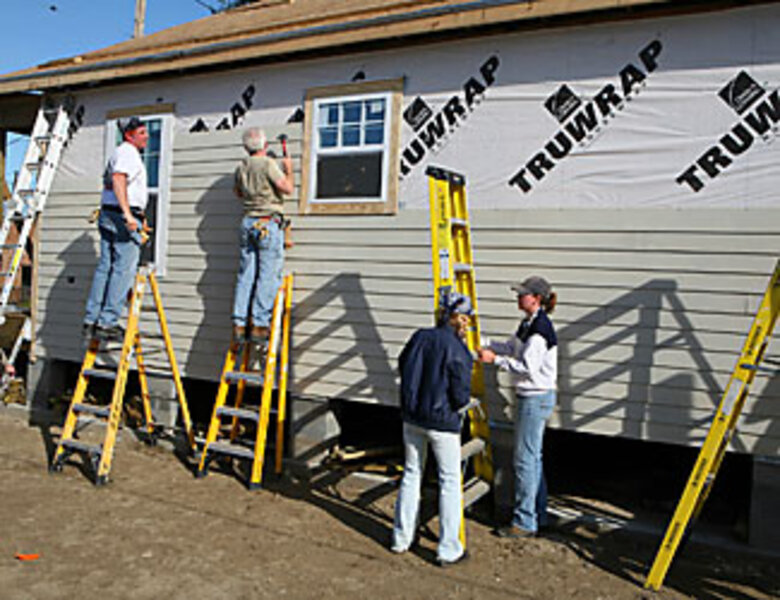What Katrina has wrought, four years later
| New Orleans
For the survivors, hurricane Katrina lives in memories, photographs, and the empty spaces left by lost friends and objects.
Its immediate toll was tragedy. The storm that crashed into New Orleans and the Mississippi Gulf Coast four years ago wreaked a shocking $80 billion in damage and resulted in 1,836 confirmed fatalities. But since then, its overall legacy has broadened and, one hopes, has not been all bad.
Count these among the lessons it taught and the changes it spawned:
•Volunteers matter a lot in a time of crisis.
•FEMA's mission has shifted from a top-down to a bottom-up approach.
•New appreciation has emerged of the need to retain and restore wetlands to help absorb storm surges.
•Storm-tracking capabilities have advanced in ways that improve public safety.
•Hurricanes have moved to the center of the climate-change debate.
"Katrina has become a symbolic event," says Russell Dynes, founding director of the University of Delaware's Disaster Recovery Center, in Newark.
The limits of centralized response
The storm four years ago ripped apart the fabric of New Orleans, but it also left a deep impression on emergency response workers nationwide. It showed, for one thing, how volunteer efforts – churches, college students – played a much more important role than expected and how the centralized response, led by the Federal Emergency Management Agency (FEMA), alienated many of the same people it was intended to help.
After Katrina, the Federal Emergency Management Agency (FEMA) overhauled its National Disaster Plan, incorporating a more bottom-up approach and going back to its roots as a civil, not military, response unit. FEMA's current director, Craig Fugate, is intent on setting policy to reflect his belief that citizens are less victims than crucial first responders.
In fact, Mr. Fugate has changed FEMA's mission statement from "protect the nation from all hazards" to a more collaborative offer to "support our citizens and first responders to ensure that as a nation we work together."
As exemplified by last year's responses to hurricanes Ike and Gustav, evacuation models have improved since Katrina's landfall. Instead of standing idle in parking lots, buses – and even locomotives – were employed to get poorer residents out of harm's way and into charity-organized shelters, sometimes hundreds of miles away.
But one thing Katrina has not forestalled is the seemingly unstoppable migration of people to the coast. "From a policy standpoint, Katrina changed a number of things," says Jay Baker, an emergency response expert at Florida State University (FSU), in Tallahassee. "But I'm not sure from a public perception of risk it really changed much."
Nature as friend, not just foe
Katrina refocused disaster-mitigation policy on the role of wetlands and other natural systems to help defend human enclaves on the coast. New protection plans in New Orleans and Louisiana include restoring surrounding marshland – much of which had been eliminated by projects like the Mississippi River Gulf Outlet ("Mr. Go") canal in the 1960s.
"Everybody has realized that you can't simply wall off New Orleans by levees. You have to also activate the natural defenses that lie in the wetlands," says New Orleansian Jed Horne, author of "Breach of Faith," which documents how a natural event became a man-made disaster.
The slow pace of rebuilding of the levees – and a failure to invest in a protection system that would withstand another storm of Katrina's strength – has deepened distrust in New Orleans about US resolve to safeguard the Crescent City.
A report by the Institute for Southern Studies, released this week, gave the Bush administration a D-minus for its handling of Katrina recovery. The new Obama administration gets only a slightly better D-plus.
Rise of the storm killers
The US government's storm-tracking plane had to be grounded as Katrina approached New Orleans, for lack of money. That won't happen again.
But the hurricane also accelerated research into storm-tracking models, which have made today's five-day forecasts as accurate as the old three-day forecasts. Intensity modeling, however, is lagging.
Because of its deadly and expensive destruction, Katrina has also played into growing arguments over the role of climate change on storm frequency and intensity.
Property insurers cite Katrina and other signs of greater storm frequency and intensity to argue for higher rates in states from Florida to Massachusetts, part of what some critics see as Katrina's role in the politicization of climate change science, says Jim O'Brien, an oceanography professor at FSU.
And thanks partly to Katrina, Microsoft founder Bill Gates has devised a plan to drop buoys carrying pumps into the ocean path of an oncoming hurricane to churn up "hurricane-killing" cold waters. But there are political implications: What happens if such an effort to protect the US mainland were to steer a hurricane into Mexico, or Cuba?
'Salvation in times of crisis'
For others, Katrina's legacy is not as tangible, but it's no less important.
For San Francisco essayist Rebecca Solnit, media coverage of Katrina mayhem – some true, much of it not – drove a panicked, paranoid response that overshadowed the calm humanitarian work that actually defined the days after the storm.
"There is some incredible ugliness to the truth about Katrina," Ms. Solnit writes in The Guardian. "But, four years on, the lies hide more beauty, and hide where our dangers and our salvation may lie in times of crisis."





